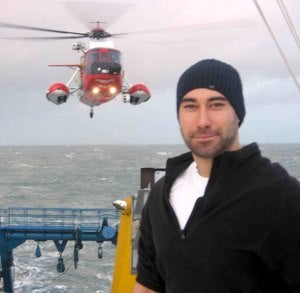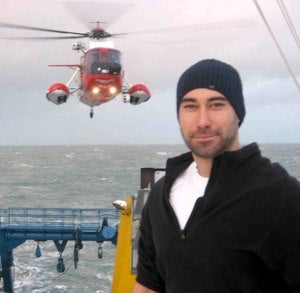 Voorheesville native to graduate May 21
Voorheesville native to graduate May 21
NARRAGANSETT, R.I. – May 3, 2011 – As a swim instructor and lifeguard in high school, Matt Horn loved being in or near the water. But when it came to a career, he considered engineering or medicine before his affinity for the water caught up with him.
Now he prepares to graduate with a Ph.D. in oceanography from the University of Rhode Island after six years of tracking nitrogen around the world’s oceans and tracing its relationship to carbon dioxide in the atmosphere.
A native of Voorheesville, N.Y., Horn moved to URI just three days after earning a bachelor’s degree from Cornell University, and just three weeks later he went to sea for the first time to begin his research. He began by trying to learn how CO2 moves from the atmosphere into the ocean and back again.
“It enters the water under high wind speed conditions, but most oceanographers only like to go to sea when it’s calm,” he said. “So I had to go to sea in the worst conditions and try to convince the ship’s captain to drive into the middle of the perfect storm.”
On an expedition aboard a 300-foot British research ship north of Scotland in 2007, he experienced 120-knot winds and 50-foot seas and eventually had to get rescued by the Coast Guard.
“After 42 days at sea we only were able to work for two or three days total,” he recalled. “The rest of the time we were hunkering down and trying to ride out the weather. It was an expensive trip and we lost a lot of gear, but we made it back safely.”
Half way through his degree, he changed his research focus to study diatoms that live at the surface of the Southern Ocean near Antarctica, one of the only places in the world where CO2 both enters and exits the ocean. He grew diatoms – single celled marine plants – in a laboratory under conditions resembling the Antarctic and analyzed the relationship between stable isotopes in their cells to the isotopic relationship found in sediment core samples from 30,000 years ago.
“CO2 levels have bounced around between 180 parts per million and 280 parts per million from one glacial cycle to another,” Horn said. “Now we’re at 390. I was looking to learn how nutrient utilization changed in the Southern Ocean and what kind of variability that has on CO2 levels over Earth’s history and see what it means for today.”
While this latter project did not involve travel to the Southern Ocean, he still looks back nostalgically on his time spent at sea.
“Life is simple at sea,” he said. “It’s just you and your work. You get to know the people you work with well, you see so many new places, and you see a lot of water. There was great excitement in the unknown. But I also enjoyed seeing a different side of oceanography with all of my lab work, too.”
After graduation, Horn begins work as a chemical oceanographer at Applied Science Associates, just a few miles down the road from the URI Graduate School of Oceanography. He looks forward to applying his diverse background and experience to the company’s projects tracking oil and chemicals in the ocean and addressing other coastal and environmental hazards.
“I’m looking forward to getting out of academia and working in the private sector,” Horn said. “Some day I may see myself starting my own company or maybe try teaching. But I’ve been in school for 25 years now; it’s time to spread my wings a little bit and make a difference.”

